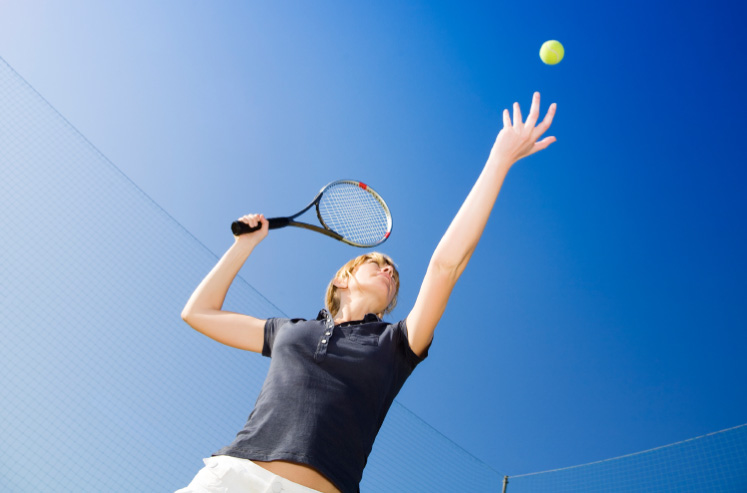Sports-specific repetition is critical for expert strategic moves, instantaneous reactions and deadly accuracy. But, aside from frequent games and practice warm-ups, varying your workouts will get you consistently to match point. Always consult your doctor before starting this or any workout regimen.
Aerobic Endurance
Aerobic capacity is essential for a first-rate tennis performance. Serves, returns and volleys demand repeat high-intensity activity at a level of competence that should remain steady throughout the match. You could be out on the court, some days in blazing sun, for hours — so endurance is another factor that affects performance.
Cardio Tennis was developed by the United States Tennis Association to provide a non-stop, powerful, high-energy, calorie-consuming aerobic workout for tennis players or anyone interested in full-body fitness. Sign up for a Cardio Tennis class to improve your game, whether you are a beginner or a ranked amateur competing in weekend tournaments. You’ll do a warm-up, cardio workout and cool-down, followed by a game. The workout segment runs from 60 to 90 minutes and includes challenging sessions of hitting balls coming at you from every angle of the court, jumping rope, jumping hurdles, moving back and forth and side to side, intervals, calisthenics to fast music, stretching, and a little strength training for good measure.
Strength Training
The leisurely gentlemen’s game is a thing of the past. Tennis today is about powerful serves, slamming backhands and lightning-fast forehands driven deep into your opponent’s court. It’s not badminton; you need real muscle to dominate your game. Maxed-out foundational strength is the answer. Segment your strength training into off-season, pre-season and in-season workouts with free weights and resistance machine sessions.
Add planks and crunches on a stability ball. Intensify the level from basic strength training to sustained muscular endurance with rowing, squats and leg presses as you approach tennis season. Train the large muscles — the glutes, quads, hamstrings, calves and core — but don’t neglect your shoulders and arms. Upper-body stress injuries can end your game before the first toss. Forearm, wrist and rotator cuff exercises with light weights can help you to avoid tennis elbow and problems with your serve.
Explosive Power
Unbeatable tennis players must have the ability to erupt into action. Their serves and returns are explosive moves; they travel from the baseline to the net in a heartbeat. A plyometric program can boost your game to the next level and keep it there. Plyometrics, sometimes known as box jumping, is best added in the lead-up to tennis season and should be practiced no more than two or three times a week. Implement a plyometrics program with an experienced coach — it’s more intense than it first appears and can lead to injury when attempted without expert guidance.
For tennis fitness, use plyometrics drills like squat jumps, hurdle jumps with sprints, box jumps, ladder and ring drills, and side throws and over-the-back tosses with a medicine ball. Work with a coach who knows both plyometrics and tennis to ensure correct form and to match the exercise challenge to your ability. Combine explosive plyometrics with agility training for significant gains in your game. The U.S. Tennis Association recommends alternating days of lateral moves with days of forward and back moves to mimic your action on the court.
Competitive Fitness
Copy the pros who use cross-training and fitness coaching to enhance their natural ability and nail titles. Top competitor Roger Federer began winning important matches after hiring a personal trainer and devoting himself to year-round workouts. His tennis coach and fitness trainer created an integrated program of varied exercises coupled with practice to prevent boredom. Some days Federer would run around the practice court to exhaustion and then play a game so his coach could isolate his default problem moves and correct them.
Tennis pro Carolyn Wozniacki tailors her workouts to tennis-specific moves. She drills repetitively to refine her serve or return, spending entire sessions on one or two moves. Then she hits the gym for intense treadmill runs and sprint intervals, and weight training on the speed bag and heavy bag. The boxing improves her hand-eye coordination on the court as well as building upper body strength and overall endurance.
References & Resources
Sports Fitness Advisor: Tennis Training Section
World Tennis Magazine: Roger Federer’s Fitness Guru
Sports Fitness Advisor: The Elite Approach to Tennis Strength Training
Times-Union: Tennis with a Shot of Caffeine
WSJ magazine: Caroline Wozniacki: Net Gains
Sports Fitness Advisor: Complete, Annual Tennis Weight Training Program
USTA: Strength & Conditioning: Plyometric Exercises for Tennis





